|
Trait Attribution and Its Logic
This section develops affect control theory's
equations for trait attribution and then analyzes the logic of trait
attribution, comparing that logic with the logic applying to mood attribution or
to labeling with new identities.
Affect control theory treats a personal trait as a
trans-situational particulizer of identity. The EPA profile, p, combines
with the situational identity that a person adopts, r, and generates the
personal fundamental profile, fS, that the self confirms in
the situation.
In reidentification, fS specifies
the personal self that accounts for a past event when the event is viewed as
confirming fS.The profile for the personal self that is
affirmed by a given event is defined by equation (46)
if reidentifying an actor ("who would do such an action?") or by
equation (54) if reidentifying an object ("Who
befits such an action?"). When these equations were presented, the profiles
that they define were used to label the individual with a new identity. Now,
however, fS is viewed as an amalgamation of trait and role,
and we seek to specify the trait that combines with the individual's role
identity in such a way as to explain the observed event.
Knowing the profile, fS, that is
being confirmed situationally, the next question is what trait profile, p,
is required in order to convert the profile for the person's situational
identity, r, into fS? The solution is obtained via (62b)
- the same equation as was used in developing an emotion model, except we now
change the symbols standing for emotion (E, e, Ee,
Ep, Ea) to symbols standing for any
particularizer (P, p, Pe, Pp, Pa),
and we change the q standing for a transient
to fS since we are accounting for an inferred fundamental
state instead of accounting for a transient state. With these substitutions, and
understanding the other terms as defined for equation (62b),
the solution is the same as for the emotion model, Equation (63).
 (65) (65)
[The section above, including the equation, was
revised October, 2000.]
The model has some implications regarding trait
inference, as it did for emotions. First, the trait that is
inferred in order to account for a particular event will vary depending on the
person's initial situational identity. Thus, participating in the same happening
in the same way could imply different traits for people with different
identities. Second, trait inferences about a person with an
extremely negative situational identity should be chaotic, depending on minor
variations in participation.
Now I turn to the logic of constructing notions of
people.
Logic of Person Construction
Personality traits (like "introverted" or
"hostile") distinguish the manner in which an individual participates
in events from the manner that is expected due to situation. If we focus on
attributional processes, then traits amount to interpreting abnormal situational
participation as normal individual participation. If we focus on personality
theory, traits are dispositions for individualistic styles of participation that
cause abnormal situational participation.
 (66) (66)
EPA profiles for situational identities produce
normal situational participation as the individual attempts to confirm the
profiles through event constructions. In particular, situationally-normal
participation requires events that minimumly deflect transients from the
fundamental self profile, fS, corresponding to the person's
situational identity, or participating in events that repair a prior
non-confirmatory event by maximally reducing deflections left from the prior
event. Accordingly, abnormal situational participation consists of
participating in events that do not minimize deflections from fS,
while failing to participate in events that could reduce fS
deflections when such repair events are possible.
Thus the schematic above can be rewritten as follows.
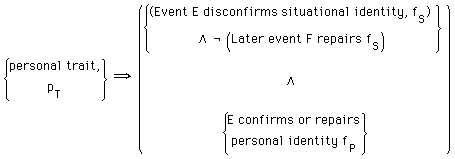 (67) (67)
By this formulation traits are
evident only in retrospect after it is clear that a situationally abnormal event
will not be repaired. In particular, the trigger for attributing a trait
consists of (1) an event that disconfirms a person's situational identity, (2)
an opportunity to participate in an event that would repair the consequences of
the prior disconfirming event, and (3) foregoing the repair opportunity. At that
point, a trait that accounts for the first event is required in order understand
the person's actions, and attributing such a trait explains the person's
individualistic participation in the situation.
A trait is a trans-situational modifier of identity,
so assigning a trait has implications beyond the immediate situation.
 (68) (68)
Transposition yields the conditions for a trait being absent.
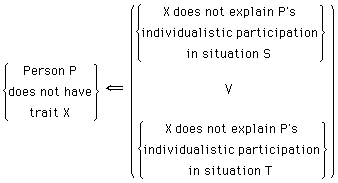 (69) (69)
By this formulation, inference of a particular trait that
explains a person's current behavior is abandoned if a disconfirmation in
another situation is recollected (a disconfirmation is an instance in which the
person acted abnormally, assuming he or she has the trait). A trait inference is
warranted as long as no such instance is recollected.
Reidentification includes several possibilities aside
from trait inference. First, one might suppose that an individualistic style of
participation causing abnormal situational participation arises from a mood - a
situational rather than trans-situational disposition. The participatory
conditions for a mood attribution are the same as for a trait attribution -
proposition (67). However, the logic for presuming a mood is different. Instead
of (68) we have
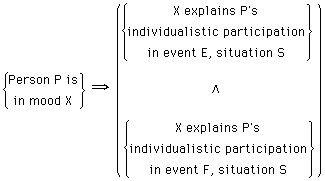 (70) (70)
and the transposition gives conditions for a mood being absent
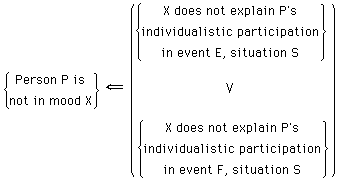 (71) (71)
Thus a mood attribution has to explain any recollected
individual idiosyncracy in the current situation in order to be warranted.
Second, one might suppose that situationally abnormal
participation arises not from modification of situational identity but from
adoption of a governing social identity other than the one believed to be
operative. To have an institutionalized social identity a person must be
established in the identity through ritual commissioning or by ascription from
physical features.
 (72) (72)
Considerable community work would be required to give an institutionalized
identity to someone who does not already have it. This contrasts to the personal
accounting of a person's actions through trait attributions.
A person has an informal social identity if there
exists a circumstance - a specific event opportunity in a given situation - in
which the person participates in a role production associated with the identity
while foregoing role actions for alternative identities that would be
appropriate in that circumstance.
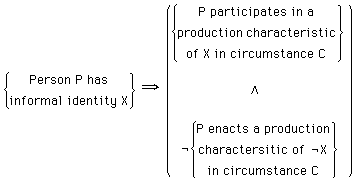 (73) (73)
The transposition defines the conditions for rejecting the notion that a
person has the informal social identity.
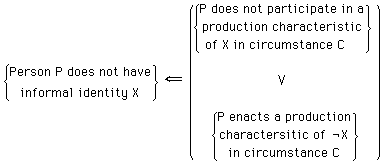 (74) (74)
Thus an attribution of informal identity is unwarranted if no instance can be
recalled in which the person did the kind of thing characteristic of that
identity. It also is unwarranted if in every recollected circumstance the
person's participation can be interpreted as an action characteristic of other
appropriate identities. In particular, an abnormal
participation with regard to one situational identity does not warrant inference
of a new informal identity if the person's participation always can be viewed as
confirming or repairing other identities in his or her situational repertoire of
roles.
   
URL: www.indiana.edu/~socpsy/ACT/math/eq_5.html
Document: David
Heise, "Affect Control Theory's Mathematical Model, With a List
of Testable Hypotheses. A Working Paper for ACT Researchers."
February 7, 1992. Revised and posted on the World Wide Web, April 15,
1997.
|
| 